Coding Standards
- 2. A bitter pill I know one of the company, in the late 80s, wrote a killer app. It was very popular, and lots of professionals bought and used it. But then the release cycles began to stretch. Bugs were not repaired from one release to the next. Load times grew and crashes increased. I remember the day I shut the product down in frustration and never used it again. The company went out of business a short time after that. ContinuinedĄ Courtesy clean code book ? Robert C martin
- 3. A bitter pill Two decades later I met one of the early employees of that company and asked him what had happened. The answer confirmed my fears. They had rushed the product to market and had made a huge mess in the code. As they added more and more features, the code got worse and worse until they simply could not manage it any longer. It was the bad code that brought the company down. Courtesy clean code book ? Robert C martin
- 4. Why coding standard are important ? Easier to understand which in turn results in a code, which is easier to develop and maintain. ? Code that is difficult to understand and maintain runs the risk of being scrapped and rewritten. ? Greater maintainability. ? Greater scalability. ? Greater productivity.
- 5. Common excuse Why does this happen to code? Why does good code rot so quickly into bad code? We have lots of explanations for it. We complain that the requirements changed in ways that original design. We the schedules that were too tight to do things right. We blather about stupid managers and intolerant customers and useless marketing types and telephone sanitizers. But the fault, is not in our stars, but in ourselves. We are unprofessional. No. The managers and marketers look to us for the information they need to make promises and commitments; and even when they donĄŊt look to us, we should not be shy about telling them what we think. ContinuinedĄ Courtesy clean code book ? Robert C martin
- 6. True professionals know that the second part of the is wrong. You will not make the deadline by making the mess. Indeed, the mess will slow you down instantly, and will force you to miss the deadline. The only way to make the deadlineĄŠthe only way to go fastĄŠis to keep the code as clean as possible at all times. LetĄŊs say that you accept that the only way to go fast is to keep your code clean. Then you must ask yourself: Ą°How do I write clean code?Ąą Courtesy clean code book ? Robert C martin
- 7. Bjarne Stroustrup, inventor of C++ and author of The C++ Programming Language I like my code to be elegant and efficient. The logic should be straightforward to make it hard for bugs to hide, the dependencies minimal to ease maintenance, error handling complete according to an articulated strategy, and performance close to optimal so as not to tempt people to make the code messy with unprincipled optimizations. Clean code does one thing well. Reading it should make you smile the way a well- crafted well-designed car would. Courtesy clean code book ? Robert C martin
- 8. Naming Convention ? Never use single letter or abbreviation ĻC Why ? Because your brain needs to compile those words AND DO MAPPING so your focus is lost. READIBILITY DECREASES ? Use full English descriptors that accurately describe the variable/field/class/interface ? For example, use names like firstName, grandTotal, or CorporateCustomer (camel casing), ? Use mixed case to make names readable. ? Avoid names that are similar or differ only in case
- 9. Meaning full name ? Choosing good names takes time but saves more than it takes. ? Everyone who reads your code (including you) will be happier if you do. ? The name of a variable, function, or class, should answer all the big questions. ? It should tell you why it exists, what it does, and how it is used. If a name requires a comment,then the name does not reveal its intent.
- 10. Implication for (int j=0; j<34; j++) { s += (t[j]*4)/5; } to int realDaysPerIdealDay = 4; const int WORK_DAYS_PER_WEEK = 5; int sum = 0; for (int j=0; j < NUMBER_OF_TASKS; j++) { int realTaskDays = taskEstimate[j] * realDaysPerIdealDay; int realTaskWeeks = (realdays / WORK_DAYS_PER_WEEK); sum += realTaskWeeks; } Not all the times third person will be able to understand the code if the naming convention is cryptic. People may miss understand the code. Which leads to Ą.
- 11. Solution ? So go ahead and use computer science,domain terms, algorithm names, pattern names, math terms, and so forth.
- 12. Functions ? The first rule of functions is that they should be small. The second rule of functions is that they should be smaller than that. ? Functions should hardly ever be 20 lines long. ? It will difficult for BRAIN to map if it extends the screen size .
- 13. Function ? Each function should narrate a story. ? FUNCTIONS SHOULD DO ONE THING. THEY SHOULD DO IT WELL. ? Following this principle will bring different levels of abstraction. ? Gets of lots of reusability on board.(avoid duplication) ? Testable
- 14. Functions ? Naming member functions ĻC The first word of the member function should be a verb. ? Naming Accessor Member Functions ĻC Use prefix Ą°getĄą to the name of the field / attribute / property. ĻC Use prefix Ą°isĄą to the name of the field / attribute / property if the field is Boolean ĻC Examples ĻC getFirstName() ĻC isPersistent()
- 15. Function ? A long descriptive name is better than a short mysterious name. ? A long descriptive name is better than a long descriptive comment. ? Use a naming convention that allows multiple words to be easily read in the function names, and then make use of those multiple words to give the function a name that says what it does.
- 16. Comments ? The reason is simple. Programmers canĄŊt realistically maintain them. ? Only when non obvious are coded. ? Only the code can truly tell you what it does. It is the only source of truly accurate information ? Ą°DonĄŊt comment bad codeĄŠrewrite it.Ąą ? Nothing can be quite so damaging as an old jargon comment that propagates lies and misinformation. ? Every time you write a comment, you should feel the failure of your ability of expression.
- 17. Comments // Check to see if the employee is eligible for full benefits if ((employee.flags & HOURLY_FLAG) && (employee.age > 65)) Or this? if (employee.isEligibleForFullBenefits()) // format matched kk:mm:ss EEE, MMM dd, yyyy Pattern timeMatcher = Pattern.compile( "d*:d*:d* w*, w* d*, d*");
- 18. comments ? Clarification ? Warning of Consequences ĻC Example @Ignore("Takes too long to run"). ĻC //SimpleDateFormat is not thread safe, ĻC //so we need to create each instance independently. ĻC TODOs are jobs that the programmer thinks should be done
- 19. Comments // Utility method that returns when this.closed is true. Throws an exception // if the timeout is reached. public synchronized void waitForClose(final long timeoutMillis) throws Exception { if(!closed) { wait(timeoutMillis); if(!closed) throw new Exception("MockResponseSender could not be closed"); } }
- 20. Naming ? Constants All in upper case . ĻC MINIMUM_BALANCE Variable should start with small letter ĻC Single letter are only allowed in loops i.e., i,j. For Interfaces START WITH I
- 21. ? DonĄŊt show the intelligence. Most often intelligent code result in bug and maintenance issue. ? Write the logic in very straight forward way. So that it is easy for third person to understand. ? Writing software is like any other kind of writing like article. ? You get your thoughts down first, then you massage it until it reads well.
- 22. Unit Tests ? Why testing? ĻC Improve software design ĻC Make software easier to understand ĻC Reduce debugging time ĻC Catch integration errors ? In short, to Produce Better Code ? Kent Beck developed the first xUnit automated test tool for Smalltalk in mid-90ĄŊs. ? Junit has become the standard tool for Test-Driven Development in Java (see Junit.org)
- 23. Unit Tests Basics of software testing There are two basics of software testing: blackbox testing and whitebox testing. ? Blackbox Testing Black box testing is a testing technique that ignores the internal mechanism of the system and focuses on the output generated against any input and execution of the system. It is also called functional testing. ? Whitebox?Testing? White box testing is a testing technique that takes into account the internal mechanism of a system. It is also called structural testing and glass box testing.
- 24. Types of testing ? There are many types of testing like ? Unit Testing ? Integration Testing ? Functional Testing ? System Testing ? Stress Testing ? Performance Testing ? Usability Testing ? Acceptance Testing ? Regression Testing ? Beta Testing?? ? Smoke and sanity testing ? Security testing
- 25. Junit Components ? Override the setUp() method to initialize object(s) under test. ? Override the tearDown() method to release object(s) under test ? assertX methods ? assertEquals(expected, actual) ? assertNull(Object?object) ? static void assertTrue(boolean test) ? static void assertFalse(boolean test)
- 26. Results Your results are here
- 27. Other general info ? About Agile Development. ? About Test Driven development. ? Fit ĻC Testing based on Tables ? Cucumber ĻC Testing based on Modern language ? Selenium ĻC UI Driven testing framework. ? About Usability ĻC book by nameĄ°Dont make me thinkĄą ? JPGL: JPA Hibernate, Design patterns ĻCHead first design patterns

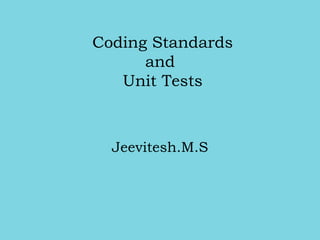


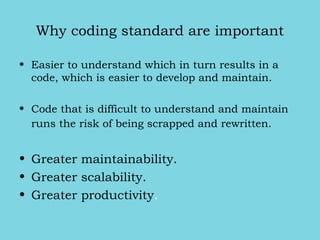



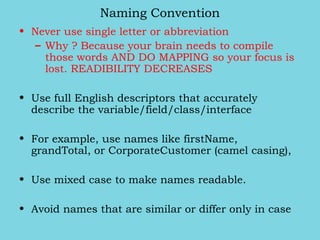

![Implication
for (int j=0; j<34; j++) {
s += (t[j]*4)/5;
}
to
int realDaysPerIdealDay = 4;
const int WORK_DAYS_PER_WEEK = 5;
int sum = 0;
for (int j=0; j < NUMBER_OF_TASKS; j++) {
int realTaskDays = taskEstimate[j] * realDaysPerIdealDay;
int realTaskWeeks = (realdays / WORK_DAYS_PER_WEEK);
sum += realTaskWeeks;
}
Not all the times third person will be able to
understand the code if the naming convention
is cryptic.
People may miss understand the code. Which
leads to Ą.](https://image.slidesharecdn.com/e4a12ba2-1b77-45c6-b7f1-77c11fa797fe-160417095654/85/Coding-Standards-10-320.jpg)











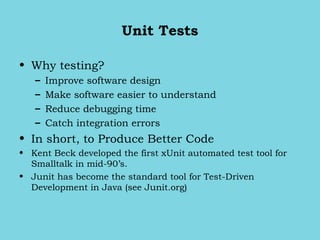




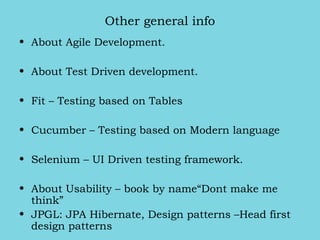





















![[DevDay2018] LetĄŊs all get along. Clean Code please! - By: Christophe K. Ngo,...](https://cdn.slidesharecdn.com/ss_thumbnails/christophek-180419103038-thumbnail.jpg?width=560&fit=bounds)












